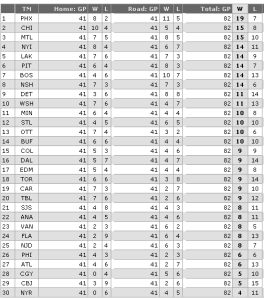Is Parity Sustainable in a 30 Team NHL? and The NHL NEEDS to Fix the Point System
The NHL playoffs are underway and there have been multiple ‘upsets’ and some tight and exciting games in this year’s opening round. I think it shows just how much parity there is in the league. Yes, the Eastern Conference had a 33 point spread between the first and last placed playoff teams (an 18 point spread in the West) but the playoffs are showing that when the Cup is on the line, a 33 point spread might not mean all that much.
In some ways, we should expect this. With salary caps and a league that holds 30 teams, it makes sense that concentrated talent on a team, like that which was on the Edmonton Oilers of old, is something that will be hard to build. Add to that the AHL, from which NHL quality players (NHL quality for a 30 team league) are shuffled back and forth at will and the talent pool that the NHL utilizes is deep and broad.
This means that teams, even if they are injury riddled, can stay competitive and pickup points, until playoff time. Then if they can stay healthy through the playoffs, expect them to make some noise, even if they don’t have the horses to make it to the Cup finals.
Is this good or bad? In some ways it’s great for hockey but it also means that the NHL/AHL network, broad as it is, probably isn’t as Elite as we’d like to think it is. Sure, great athletes are in the mix, but in general, it’s the teamwork that makes the teams, and teamwork doesn’t sign contracts for millions of dollars -dollars that have to be made somewhere, usually in rising ticket prices.
So, in a weird twist, even with salary caps, this huge league network may have the seeds of becoming unsustainable because the distinguishing element of the league is not tied directly to team income.
Bizarre, isn’t it?
Speaking of bizarre – let’s please stop rewarding ties in the NHL. I did a quick crunch (and included the table below) and found that teams in the NHL decided their games in overtime 26% of the time; that’s 21.07 OT games per team!
In some ways this highlights the parity I spoke of above. It also shows that a quarter of each team’s points, on average, are points coming out of overtime competition. Since teams get at least a point for making overtime happen, this also means that teams are racking up the points.
Let’s look at an example:
A team goes into OT 21 games a year. Let’s say they split, winning 10 games (in shootouts and OT) and lose 11.
Say our team is roughly a .500 team, winning 41 games total (31-30 in regulation). This means:
31 wins in regulation+10 wins in OT + 11 losses in OT = 93 points.
Yup, a team that ‘wins’ half its games, and gets into overtime an average amount of times, will have a 41 – 30 – 11 record and 93 points. (Which incidentally seems to roughly define the cutoff point for teams not making the playoffs)
Now it gets fun.
If this team is tenacious and keeps from losing in OT but is great in the shootout, getting seven more wins (48-30-4) they have 100 points and they’ve only played .500 hockey during regulation with 21 games ending in OT. That means a team that won 31 games in regulation has 100 points.
Am I the only one that sees this is wrong?
Thoughts?
Explore posts in the same categories: AHL, hockey, NHL, Playoffs, Stanley Cup, Statistics, The Future of HockeyTags: AHL, hockey standings, NHL, NHL point system, Overtime, parity in the NHL, Playoffs, shootout, stanley cup playoffs
You can comment below, or link to this permanent URL from your own site.
June 11, 2010 at 8:59 pm
I think you’re spot on once again! There are a lot of things that i think need to be revamped, and this is definitely one of them.
And congrats to your boys! Can’t believe I haven’t seen a post on this yet!!
June 12, 2010 at 12:16 am
Thanks Jake for your thoughts and the congrats! The post is out!